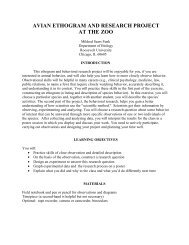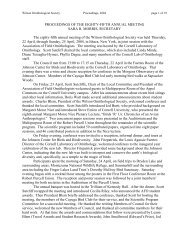Available now - Wilson Ornithological Society
Available now - Wilson Ornithological Society
Available now - Wilson Ornithological Society
You also want an ePaper? Increase the reach of your titles
YUMPU automatically turns print PDFs into web optimized ePapers that Google loves.
WOS 2010 ~ ABSTRACTS p. 10<br />
ABSTRACTS – PLENARY & SYMPOSIUM PRESENTATIONS<br />
Presenting authors are indicated by bold type. Symposium talks are arranged by presentation number.<br />
Margaret Morse Nice Lecture<br />
Brood parasitism in cuckoos, cowbirds, and African finches. Robert B. Payne and Laura Payne, Museum of<br />
Zoology, Univ. Michigan, Ann Arbor, MI 48109<br />
Margaret Nice studied cowbirds and their effects on song sparrows. We draw on her work to ask some general<br />
questions about brood parasitism in birds: what is the impact of brood parasitism on the nesting hosts Are the brood<br />
parasites generalists or specialists on their hosts How has their specialization affected their evolution and<br />
speciation How did brood parasitism evolve We briefly consider the cowbirds and cuckoos, and then we describe<br />
our studies of the African brood-parasitic finches, especially the indigobirds. The brood-parasitic finches have less<br />
effect on their host brood than cowbirds (cuckoos have the greatest impact) and the young finches grow up and<br />
fledge with the host nestlings. Most Vidua finches are species-specific on certain estrildid finches, the males mimic<br />
the songs of their host species, and the nestlings mimic the host nestlings. In the field the females are attracted to<br />
mate with a male indigobird that mimics her host species. We used molecular methods to discriminate between two<br />
hypotheses of the origin of specific associations of brood parasite and host: (1) co-speciation of parasite and host,<br />
and (2) later colonization and host switch by the parasite. We report a natural population of an indigobird that has<br />
switched to a new host species. We used experimental cross-fostering tests to find the basis of learning and<br />
imprinting in the indigobirds in male song mimicry, in female choice of males that mimicked their own host species,<br />
and in female choice of species nests to parasitize. We also cross-fostered between the estrildid finches to find<br />
whether the hosts could raise young that did not match the host young, as expected if the indigobirds have shifted to<br />
new host species they did not mimic. Field observations, molecular studies and behavior experiments all indicate<br />
most of the 20 species of brood-parasitic finches are the result of host switch and later mimetic adaptation. Finally,<br />
we briefly consider a test of Darwin's explanation for the origin of brood parasitism.<br />
Symposium 1: New perspectives in migratory physiology and energetics<br />
S01 The fat of the matter: how dietary fatty acid composition affects energy expenditure of birds during migration.<br />
Scott R. McWilliams, Dept. Natural Resources Science, Univ. Rhode Island, Kingston, RI 02881, and Barbara<br />
Pierce, Dept. Biology, Sacred Heart Univ., Fairfield, CT 06825<br />
Birds use primarily fat stores to fuel migratory flights, but few studies have focused on the causes and consequences<br />
of observed seasonal changes in fatty acid composition of fat stores in birds. We tested two hypotheses that address<br />
the causes of these seasonal changes in composition of fat stores: (1) diet composition determines fatty acid<br />
composition of fat stores, and (2) birds selectively metabolize and store certain fatty acids during migration in lieu of<br />
changing their diet. Red-eyed Vireos (Vireo olivaceous) consistently chose diets with more triolein over diets with<br />
more tristearin and tripalmitin, and these preferences were similar between seasons. When we maintained vireos for<br />
two years on different semisynthetic diets, the fatty acid composition of their body fat was similar to that of their<br />
diet, and any changes over time were not consistent with the selective-metabolism hypothesis. Thus, fatty acid<br />
composition of stored fat was primarily a product of diet composition; selective metabolism possibly played a<br />
minor, but important, role. Given recent evidence that fatty acid composition of birds affects their energy<br />
expenditure during intense exercise, the implication is that birds during migration can influence the fatty acid<br />
composition of their body fat by selective feeding, and this can significantly affect the energetic cost of migration.<br />
S02 Towards a theoretical framework for avian fat storage. Edwin Price, Dept. Biology, Univ. Western Ontario,<br />
London, ON N6A 5B7<br />
It is well documented that birds primarily use fat to fuel their long-distance migrations. Fat, however, is a complex<br />
mixture of many different fatty acids that have the potential to affect flight in different ways. Nonetheless, there is<br />
little existing theory as to which fatty acids or types of fatty acids birds should store in preparation for migration. I<br />
will review recent work on the physiological effects and properties of various fatty acids in their roles as energy,<br />
structural, and signaling molecules. In particular, fatty acids are mobilized from adipose tissue at varying rates;<br />
mobilization decreases with chain length and increases with the number of double bonds. Similarly, fatty acids with<br />
more double bonds are more quickly oxidized by muscles, a pattern that may be driven in part by selectivity of the<br />
fatty acid transporter carnitine palmitoyl transferase. Dietary fatty acids can also be incorporated into muscle<br />
membranes, where they have to potential to affect membrane properties, thereby affecting exercise. I will examine<br />
the evidence for this mechanism and its relative importance for affecting flight performance. Using these recent<br />
studies as a guide, I will develop a framework for predicting which fatty acids birds should store during migration,<br />
focusing on the tradeoffs between energy storage, mobilization, and stopover refueling.





